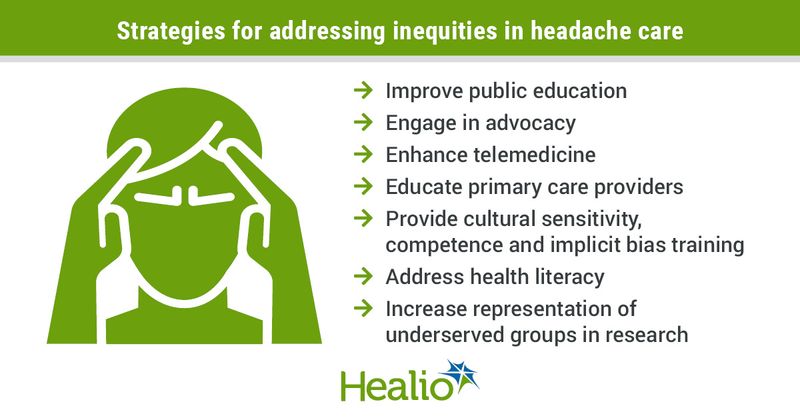'Disparities exist' in headache care, review shows
Numerous factors, including racism, socioeconomic and insurance status, and geographical disparities, contributed to “inequities” in treating headache disorders, according to the authors of a literature review published in Neurology.
“While the prevalence of migraine and severe headache disorders among white, Black and Hispanic groups in the United States is not that different, disparities exist in diagnosis, treatments and outcomes,” Jessica Kiarashi, MD, assistant professor in the department of neurology at UT Southwestern Medical Center, told Healio Neurology. “For example, Black patients and Hispanic patients are less likely than white patients to receive a diagnosis of migraine and Black men receive the least care for headache disorders globally. Black patients are also less likely to use health care settings for migraine treatment and less likely to get prescribed appropriate medication to treat migraine.”

Kiarashi and colleagues examined the “contemporary issues” related to health care disparities in headache medicine, specifically regarding race/ethnicity, socioeconomic status and geography, while also suggesting solutions for addressing these disparities. The researchers performed a series of literature search and review between June 2020 and August 2020 of PubMed and Google Scholar for essential concepts underlying disparities in headache medicine. They further refined the content “to areas most salient to our goal of informing the provision of equitable care in headache treatment” through discussions among the 16 experts, including Kiarashi, involved in the study. These experts came from “a range of headache subspecialties,” according to the study results.
The researchers identified two broad categories — headache disparities and social determinants — as well as numerous factors within each of these larger categories as contributing factors related to the “inequities” in the health care system that are present when treating headache disorders. Within disparities, Kiarashi and colleagues included race (racism), socioeconomic and insurance status, geography and other factors, including concerns that may be present for members of the LGBTQ population. Within social determinants, Kiarashi and colleagues included discrimination, social environment, insurance status, lack of specialists and lack of representation in research.
According to Kiarashi, discrimination and unconscious bias “contribute to the racial and ethnic disparities” observed in headache care.

“Over one-third of African Americans report experiencing discrimination in clinical encounters, more than one in five American Indians or Alaska Natives report experiencing discrimination and 20% of Latinos report experiencing discrimination in clinical encounters,” she said. “We know that low socioeconomic status is an independent predictor for worse health outcomes and that migraine prevalence is strongly associated with annual household income. Therefore, populations of color that are of low [socioeconomic status] are at increased risk for health disparities.”
Geographic disparities contribute to issues related to access to care because “there are not enough headache specialists to treat patients,” Kiarashi continued.
“Furthermore, the distribution of headache specialists is uneven across the country,” she said. “There are less headache specialists in rural areas and some states have fewer than two specialists. Rural patients also tend to have more challenges, as they often have to travel farther and endure longer wait times to be seen by a headache specialist.”
The researchers proposed a variety of interventions, such as better public education, advocacy, improving telemedicine, participating in community outreach to educate primary care providers, providing training in cultural sensitivity, competence and implicit bias, tackling health literacy and working toward recruitment strategies that increase representation of underserved groups within headache research, “as solutions to ameliorate disparities,” according to the study results.
Kiarashi elaborated on the proposed strategies, noting that institutional or systemic racism “plays a large role” in many of the disparities described by the researchers.
“While there are steps that can be taken to address and rectify disparities, there needs to be a major cultural shift in our society and particularly in the field of health care,” she said. “We need to implement clinical strategies such as telemedicine as well as educating primary care providers to increase access to headache medicine. Health literacy needs to be addressed to decrease misperceptions about headache disorders and decrease medication overuse headache.”
Public education and advocacy are also important in raising awareness about these disparities and identifying solutions to correct them, Kiarashi continued.
“We need to advocate for increased funding for headache medicine research and develop initiatives to improve representation of underrepresented groups in headache medicine,” she said. “Our training programs should focus on cultural competency and sensitivity to ensure that our health care providers are better able to serve our underrepresented populations.”
